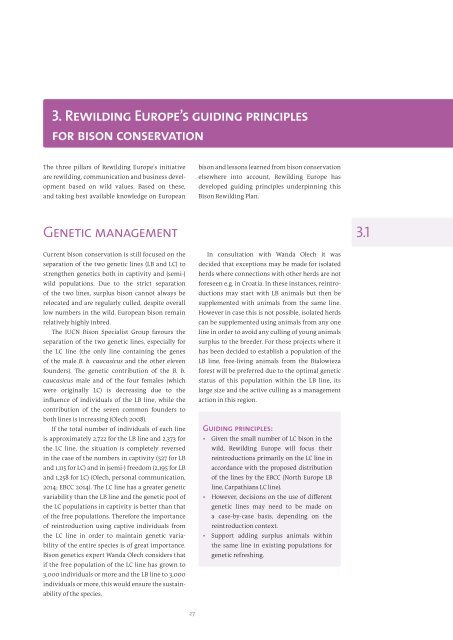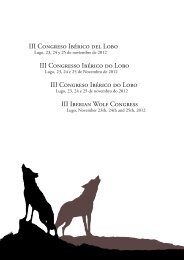Bison-Rewilding-Plan-2014
Bison-Rewilding-Plan-2014
Bison-Rewilding-Plan-2014
- No tags were found...
Create successful ePaper yourself
Turn your PDF publications into a flip-book with our unique Google optimized e-Paper software.
3. <strong>Rewilding</strong> Europe’s guiding principlesfor bison conservationThe three pillars of <strong>Rewilding</strong> Europe’s initiativeare rewilding, communication and business developmentbased on wild values. Based on these,and taking best available knowledge on Europeanbison and lessons learned from bison conservationelsewhere into account, <strong>Rewilding</strong> Europe hasdeveloped guiding principles underpinning this<strong>Bison</strong> <strong>Rewilding</strong> <strong>Plan</strong>.Genetic management3.1Current bison conservation is still focused on theseparation of the two genetic lines (LB and LC) tostrengthen genetics both in captivity and (semi-)wild populations. Due to the strict separationof the two lines, surplus bison cannot always berelocated and are regularly culled, despite overalllow numbers in the wild. European bison remainrelatively highly inbred.The IUCN <strong>Bison</strong> Specialist Group favours theseparation of the two genetic lines, especially forthe LC line (the only line containing the genesof the male B. b. caucasicus and the other elevenfounders). The genetic contribution of the B. b.caucasicus male and of the four females (whichwere originally LC) is decreasing due to theinfluence of individuals of the LB line, while thecontribution of the seven common founders toboth lines is increasing (Olech 2008).If the total number of individuals of each lineis approximately 2,722 for the LB line and 2,373 forthe LC line, the situation is completely reversedin the case of the numbers in captivity (527 for LBand 1,115 for LC) and in (semi-) freedom (2,195 for LBand 1,258 for LC) (Olech, personal communication,<strong>2014</strong>; EBCC <strong>2014</strong>). The LC line has a greater geneticvariability than the LB line and the genetic pool ofthe LC populations in captivity is better than thatof the free populations. Therefore the importanceof reintroduction using captive individuals fromthe LC line in order to maintain genetic variabilityof the entire species is of great importance.<strong>Bison</strong> genetics expert Wanda Olech considers thatif the free population of the LC line has grown to3,000 individuals or more and the LB line to 3,000individuals or more, this would ensure the sustainabilityof the species.In consultation with Wanda Olech it wasdecided that exceptions may be made for isolatedherds where connections with other herds are notforeseen e.g. in Croatia. In these instances, reintroductionsmay start with LB animals but then besupplemented with animals from the same line.However in case this is not possible, isolated herdscan be supplemented using animals from any oneline in order to avoid any culling of young animalssurplus to the breeder. For those projects where ithas been decided to establish a population of theLB line, free-living animals from the Bialowiezaforest will be preferred due to the optimal geneticstatus of this population within the LB line, itslarge size and the active culling as a managementaction in this region.Guiding principles:• Given the small number of LC bison in thewild, <strong>Rewilding</strong> Europe will focus theirreintroductions primarily on the LC line inaccordance with the proposed distributionof the lines by the EBCC (North Europe LBline, Carpathians LC line).• However, decisions on the use of differentgenetic lines may need to be made ona case-by-case basis, depending on thereintroduction context.• Support adding surplus animals withinthe same line in existing populations forgenetic refreshing.27



